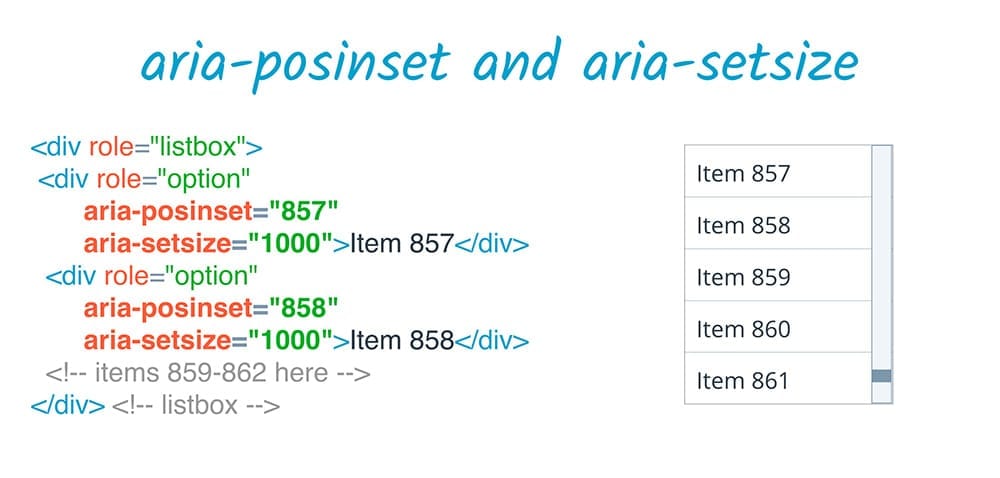Using ARIA labels to create accessible element descriptions
Labels
ARIA provides several mechanisms for adding labels and descriptions to elements. In fact, ARIA is the only way to add accessible help or description text. Let's look at the properties ARIA uses to create accessible labels.
aria-label
aria-label allows us to specify a string to be used as the accessible label.
This overrides any other native labeling mechanism, such as a label element
— for example, if a button has both text content and an aria-label,
only the aria-label value will be used.
You might use an aria-label attribute when you have some kind of visual
indication of an element's purpose, such as a button that uses a graphic instead
of text, but still need to clarify that purpose for anyone who cannot access the
visual indication, such as a button that uses only an image to indicate its
purpose.
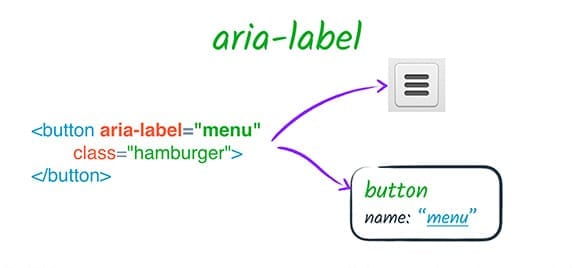
aria-labelledby
aria-labelledby allows us to specify the ID of another element in the DOM as
an element's label.
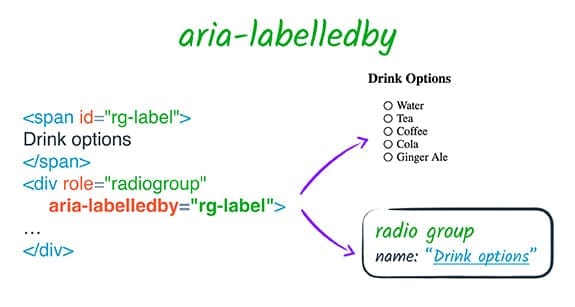
This is much like using a label element, with some key differences.
aria-labelledbymay be used on any element, not just labelable elements.- While a
labelelement refers to the thing it labels, the relationship is reversed in the case ofaria-labelledby— the thing being labeled refers to the thing that labels it. - Only one label element may be associated with a labelable element, but
aria-labelledbycan take a list of IDREFs to compose a label from multiple elements. The label will be concatenated in the order that the IDREFs are given. - You can use
aria-labelledbyto refer to elements that are hidden and would otherwise not be in the accessibility tree. For example, you could add a hiddenspannext to an element you want to label, and refer to that witharia-labelledby. - However, since ARIA only affects the accessibility tree,
aria-labelledbydoes not give you the familiar label-clicking behavior you get from using alabelelement.
Importantly, aria-labelledby overrides all other name sources for an
element. So, for example, if an element has both an aria-labelledby and an
aria-label, or an aria-labelledby and a native HTML label, the
aria-labelledby label always takes precedence.
Relationships
aria-labelledby is an example of a relationship attribute. A relationship
attribute creates a semantic relationship between elements on the page
regardless of their DOM relationship. In the case of aria-labelledby, that
relationship is "this element is labelled by that element".
The ARIA specification lists eight relationship
attributes.
Six of these, aria-activedescendant, aria-controls, aria-describedby,
aria-labelledby, and aria-owns, take a reference to one or more elements to
create a new link between elements on the page. The difference in each case is
what that link means and how it is presented to users.
aria-owns
aria-owns is one of the most widely used ARIA relationships. This attribute
allows us to tell assistive technology that an element that is separate in the
DOM should be treated as a child of the current element, or to rearrange
existing child elements into a different order. For example, if a pop-up
sub-menu is visually positioned near its parent menu, but cannot be a DOM child
of its parent because it would affect the visual presentation, you can use
aria-owns to present the sub-menu as a child of the parent menu to a screen
reader.
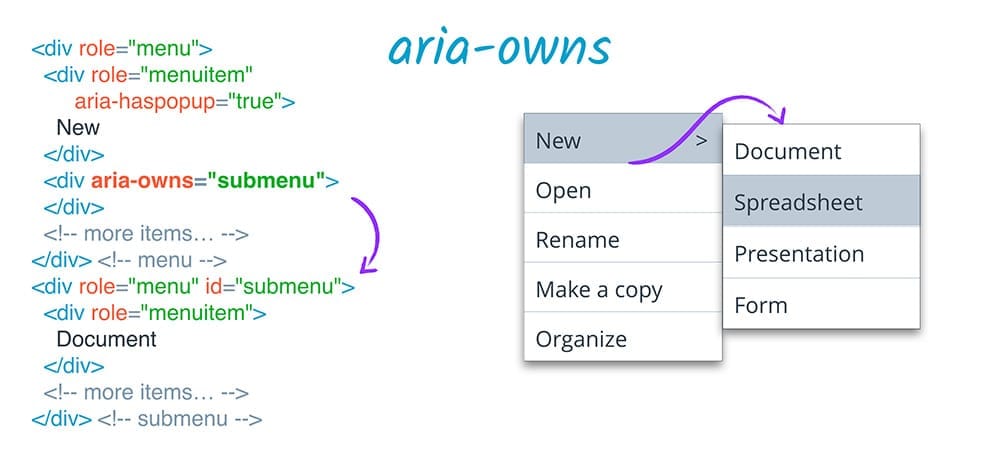
aria-activedescendant
aria-activedescendant plays a related role. Just as the active element of a
page is the one that has focus, setting the active descendant of an element
allows us to tell assistive technology that an element should be presented to
the user as the focused element when its parent actually has the focus. For
example, in a listbox, you might want to leave page focus on the listbox
container, but keep its aria-activedescendant attribute updated to the
currently selected list item. This makes the currently selected item appear to
assistive technology as if it is the focused item.
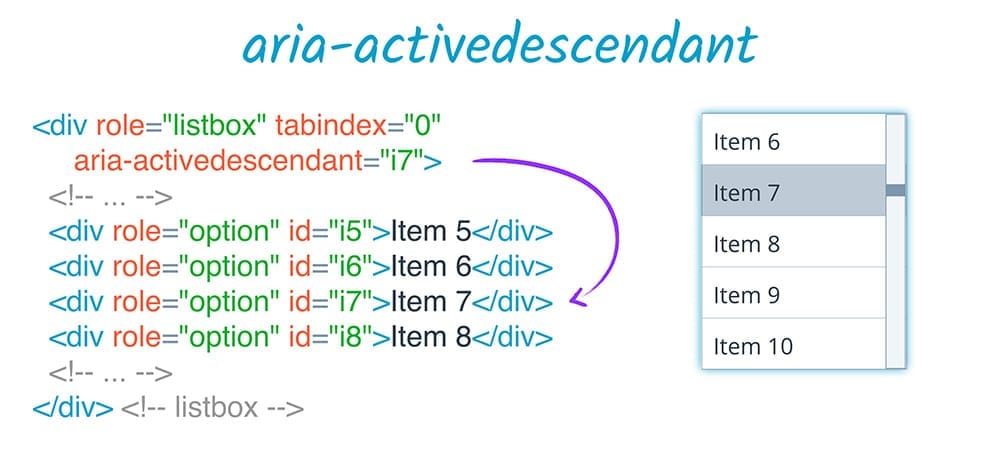
aria-describedby
aria-describedby provides an accessible description in the same way that
aria-labelledby provides a label. Like aria-labelledby, aria-describedby
may reference elements that are otherwise not visible, whether hidden from the
DOM, or hidden from assistive technology users. This is a useful technique when
there is some extra explanatory text that a user might need, whether it applies
only to users of assistive technology or all users.
A common example is a password input field that is accompanied by some descriptive text explaining the minimum password requirements. Unlike a label, this description may or may not ever be presented to the user; they may have a choice of whether to access it, or it may come after all the other information, or it may be pre-empted by something else. For example, if the user is entering information, their input will be echoed back and may interrupt the element's description. Thus, a description is a great way to communicate supplementary, but not essential, information; it won't get in the way of more critical information such as the element's role.
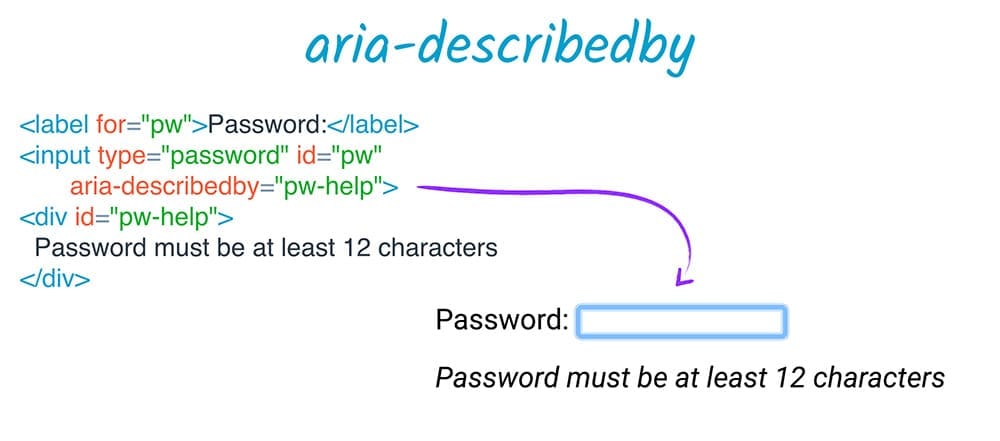
aria-posinset & aria-setsize
The remaining relationship attributes are a little different, and work together.
aria-posinset ("position in set") and aria-setsize ("size of set") are about
defining a relationship between sibling elements in a set, such as a list.
When the size of a set cannot be determined by the elements present in the DOM
— such as when lazy rendering is used to avoid having all of a large list
in the DOM at once — aria-setsize can specify the actual set size, and
aria-posinset can specify the element's position in the set. For example, in a
set that might contain 1000 elements, you could say that a particular element
has an aria-posinset of 857 even though it appears first in the DOM, and then
use dynamic HTML techniques to ensure that the user can explore the full list on
demand.
